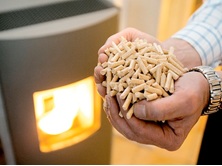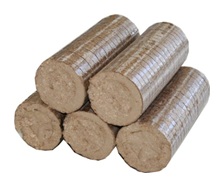1) Wood pellets
Pellet fuel is a renewable, clean-burning and cost stable home heating alternative currently used. It is a biomass product made of renewable substances – generally recycled wood waste. Wood pellets are used for heat, in freestanding stoves, fireplace inserts, furnaces and boilers. Pellets are extremely dense and can be produced with a low moisture content (below 10%) that allows them to be burned with high combustion efficiency. Pellets are produced by compressing the wood material which has first passed through a hammer mill to provide a uniform dough-like mass. This mass is fed to a press where it is squeezed through a die having holes of the size required (normally 6 mm diameter, sometimes 8 mm or larger). The high pressure of the press causes the temperature of the wood to increase greatly, and the lignin plasticizes slightly forming a natural “glue” that holds the pellet together as it cools.

2) Wood briquettes
Briquette fuels are mostly made of green waste and other organic materials, and they are commonly used for heating boilers. These compressed compounds contain various organic materials, including rice husk, bagasse, ground nut shells, municipal solid waste, agricultural waste, or anything that contains high nitrogen content. Compared to fossil fuels, the briquettes produce low net total greenhouse gas emissions because the materials used are already a part of the carbon cycle. They are cleaner and easier to handle, and cut greenhouse gas emissions.

3) Olive residues briquettes
Olive residue briquette (logs) is for time being the cheapest available heating Fuel to be used in rural small or domestic application.
